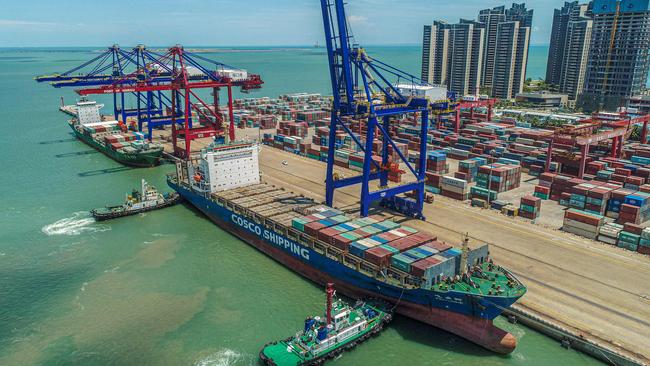
Is the $10 billion-plus China market for our food and agriculture – by far the largest and fastest growing in our region – closing even further to Australian exports due to political tensions and subsequent trade sanctions, or will some producers and exporters still manage to keep going?
The measures taken by China over the past year or so against a range of Australian exports including beef, wine, barley and lobsters is putting pressure on the sector to confront the stark reality of Australia-China ties in 2021 and step up efforts to look at other export markets.
Until about a year ago the Global Food Forum discussion panels would regularly discuss the upbeat opportunities in China, which were almost taken as a given. That has all changed in the wake of deteriorating political ties.
In the short-term, the market for some products is still there.
The March quarter agricultural outlook from the Department of Agriculture, Water and the Environment (ABARES) declares that: “Despite recent tariffs on barley and wine, China is still expected to remain Australia’s most significant agricultural trading partner.” The 112-page report steers away from discussion of the impact of Chinese trade sanctions on the agricultural export market, although it notes the industry faces a “likely more difficult environment in which to grow trade value”.
The fact is that there is no other market in the world which has the scale of the demand for food and agricultural products that China has, which makes it still worth trying to preserve what is possible.
Before Covid-19 and the Chinese trade sanctions, Australia’s food exports to China were running at about $12 billion a year – miles ahead of the $4.7 billion a year to Japan, $3.8 billion to the US and $3.3 billion to the European Union.
Even with recent trade sanctions, it has considerable potential – if things don’t get worse.
Five Australian abattoirs have been hit by import bans by Chinese authorities, but meat exports are still getting through as well as exports of dairy products and summer fruits.
Chinese consumers like Australian produce, which is known for being clean and green – a fact which saw agricultural exports soar in the wake of the tariff scrapping China-Australia Free Trade Agreement which came into force in December 2015.
The demands of a growing Chinese middle class (which consulting firm McKinsey predicts will reach 550 million people within three years) still presents opportunities for the right sellers.
Take infant formula for example. As Bubs executive chairman Dennis Lin told The Australian this week, China has some 12 million babies born each year compared with 250,000 in Australia. Assuming an infant uses baby formula for the first three years of its life, this means a market in China of 36 million prospective infant formula users a year compared with only 750,000 in Australia.
Those numbers are turbocharged if you consider the impact of China’s one child policy (moves to ease it in recent years have not made much difference to behaviour), which means that a potential six people are helping support one child in China – wanting only the best for their child and grandchild and being prepared to pay for it.
Mother and baby stores are flourishing in China. Research group IBISWorld estimates that there are more than 260,000 such stores around China turning over some $124 billion a year with more than a million staff.
Bubs shares have taken a dive on fears that its bold ambitions to sell its goat milk infant formula to China have been hit by a lack of Chinese tourists and students in Australia (the primary source of the daigou trade which was a keen buyer of Australian infant formula to send back home), as well as the increasing tensions between the countries.
But Mr Lin, who is a speaker at the forum next week, is still optimistic about the demand in China for Bubs products, while stepping up plans to expand elsewhere.
Political tensions do impact the ability to trade but they don’t always wipe it out altogether.
As those with a longer term perspective on history have noted, the US continued to export wheat to the Soviet Union even through the height of the Cold War.
China’s demand for high quality food is increasing, while its ability to supply it is limited by its relatively small amount of arable land compared to its population.
Add to that the continued drive for urbanisation, which makes agricultural production more difficult while the demands of wealthier city dwellers are rising.
China’s 14th five-year plan, for the period from 2021 to 2025, outlined earlier this year, made it clear that food security was a key national goal.
Austrade is still telling business that it sees the Chinese market for food and beverages as having continued opportunities.
But of course the message out loud and clear is that significant effort will have to go into trade diversification.
The Morrison government is working hard to be able to deliver a free-trade agreement with the UK, but British beef farmers have already expressed concern about potential imports from Australia.
There is no easy answer.
The China market is still worth pitching for, but if the government takes further provocative actions – let’s say by taking the Port of Darwin lease off its Chinese owners – more sanctions could be ahead.
The dream run for Australian food and agricultural exports in the wake of the FTA with China is over. Work is needed to preserve what trade ties there still are and a lot more work will need to be done by Team Australia in looking for more markets.








One of the challenges of next week’s Global Food Forum – the 9th annual conference sponsored by The Australian and Anthony Pratt’s Visy – will be to answer one of the major questions facing food and agricultural exporters in 2021.